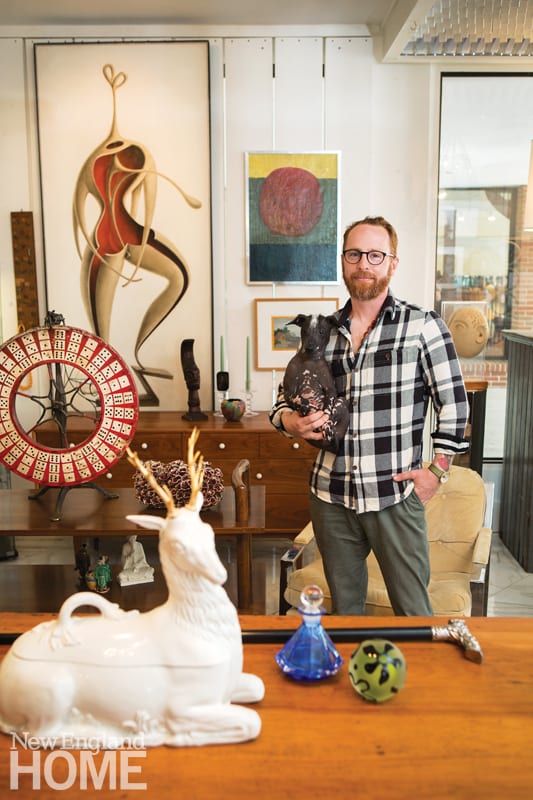Five Questions: Alex Correia of White Star Antiques
September 1, 2019
 1. You used to be a touring musician. How did you get into the antiques business?
1. You used to be a touring musician. How did you get into the antiques business?
My wife, Melanie, and I already had a background in antiques, and after I stopped touring, we crisscrossed the country in a vintage White Star camper for six months buying and selling antiques. When we got back to Providence, we talked with our friends Josh and Karen Peterson, who were both experienced antique sellers, and we all decided to open a shop that would sell the type of things we would want in our own homes. We named the shop after our camper. We source from all over the country and from people directly in Denmark, Belgium, and elsewhere. We all look for what we find to be interesting and important, especially pieces that have a story.
2. You feature a lot of midcentury modern pieces. Why is this style so popular? And does demand show signs of slowing down?
I think part of the reason it’s so popular right now is that it is easy on the eye, aesthetically. Also, people live more minimal lifestyles now, and midcentury modern pieces seem to fit, functionally. The style works with a lot of other styles and can be put in a variety of settings, say in a Victorian or Craftsman home, without overpowering the space. The popularity of midcentury modern—people use the term to describe a style, more than a period, really, and it includes Danish and Scandinavian modern—started growing in the 1990s. In the past five years it has exploded to the extent that you even have Target or Walmart reproducing things, which to me is kind of a sign that the demand may be crashing. These knockoffs dilute the look and the market. In fact, there are certain pieces that we don’t carry anymore because there are so many knockoffs. For example, you can buy a knockoff of a Harry Bertoia wire side chair for $30. A real Bertoia, licensed by Knoll, will cost more like $800. It’s the same thing with knockoffs of the Eames shell chair. Being able to buy a cheap imitation on Amazon has destroyed the market for real versions.
3. What advice do you give customers about identifying a good buy?
The most important advice is do not sacrifice quality for price. If you buy a quality piece, it will last, and it will retain—and often increase—its value, while a knockoff won’t. I also tell people that the things you regret most are not the things you buy, but the things you don’t buy. We’ve all experienced the heartbreak of falling in love with a piece, not buying it, then going back and finding it has been sold.
4. What’s a favorite, memorable find? One that made you say, “Gotta have that!”
That question reminds me of when I asked an old-timer in the antiques business, “What’s your favorite thing?” He said, “The last thing I bought.” I agree with him. My favorite thing is always the last thing I bought, because the next time I find something I’ll fall in love with that. We hand-select everything in our store, and we don’t choose anything we are not interested in ourselves. For example, although I know certain chairs are trendy, if I don’t like them, I won’t put them in the store. I confess there have been items that have blown me away, like a first-generation Eames chair (the holy grail!), which was only made for two years, and art by Picasso and Keith Haring.
5. Is the idea of what an antique is changing?
That’s an interesting question. Although it is often said that younger people are not interested in antiques, I think it’s more correct to say that, to them, the term “antique” is now kind of dated. Like, an antique is something that’s 100 years old or more. Young people are interested in things they think of as collectibles. And pieces by famous architects and influential artists are collectible. Today it is more important to find out if there a story behind a piece that sets it apart; who designed it and why was it designed.
White Star Antiques, Provincetown, Mass., whitestarantiques.com
Share
![NEH-Logo_Black[1] NEH-Logo_Black[1]](https://b2915716.smushcdn.com/2915716/wp-content/uploads/2022/08/NEH-Logo_Black1-300x162.jpg?lossy=1&strip=1&webp=1)







You must be logged in to post a comment.